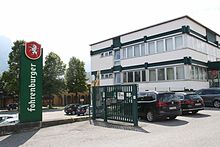Fohrenburg brewery
| Brewery Fohrenburg GmbH & Co KG | |
|---|---|
| legal form | GmbH & Co. KG |
| founding | 1881 |
| Seat | Bludenz |
| Number of employees | 106 (2013) |
| sales | € 20.45 million (2013) |
| Branch | Brewery |
| Website | www.fohrenburger.at |
The Brauerei Fohrenburg GmbH & Co KG is a beer brewery in Bludenz . After Brau Union Österreich AG, which belongs to the Heineken Group , had held 11% of the shares for several years, the majority of the brewery (74%) has been owned by Brau Union since mid-November 2019.
history
In 1880 the then 38-year-old Ferdinand Gasser built a brewery in Bludenz to supply the workers involved in the construction of the Arlbergbahn . Together with eleven other shareholders, he acquired the “Fohrenburg” inn and the associated medicinal spring Bad Fohrenburg in Hinterplärsch .
The "Fohrenburg F. Gassner & Comp. Brewery" was founded at a time when production was being revolutionized by the use of machine power. During this time, steam power was introduced into the brewery, as did mechanical mashing and lautering devices. This led to a significant improvement in the products on the one hand and also to a reduction in production costs on the other. Many small, especially rural breweries were unable to cope with this progress and were displaced by the new, more efficient breweries. Immediately after the establishment of the Fohrenburg brewery, a steam brewing plant from the company "Noback und Fritze" from Prague was purchased and installed. The first beer brew was brewed in February 1881. In the same year beer was served for the first time, which is why 1881 is considered the year the brewery was founded. The first master brewer, Josef Buß , worked as master brewer until 1907. Originally, 25 hectoliters of beer were produced daily - 8,000 hectoliters in the entire first year of production. The original brewhouse turned out to be too small in the first year. Therefore, in 1882, the brewery bought a new steam brewery from “G. Kuhn ”in Stuttgart . After enlarging the fermentation and storage cellars, production could then be increased fourfold. In the first few years around 60 cattle were kept to use the spent grains , including oxen, to transport the beer. However, cattle breeding was stopped in the first few years of operation and the spent grains were dried and sold in a row. The first bottled beer was bottled in 1884 and in 1887 the warehouse was expanded to include six more storage cellars. In 1895 a total of 38,450 hl of beer was brewed, in 1904 it was already 41,775 hl. The ever increasing demand for beer and the resulting steadily growing sales made a comprehensive renovation necessary in 1897 - the storage cellars were expanded again and the capacity of the brewing facility more than doubled. Dark beer of the Bavarian style and light beer of the Pilsen style were brewed. In 1897 the brewery was converted into a limited partnership. The founder, Ferdinand Gasser, ran the business until his death in 1926. The first master brewer, Josef Buß, retired in 1907 and was replaced by Karl Kirstein, previously at the Jenbach brewery .
In 1912 the Fohrenburger brewery was rebuilt with the installation of a new cooling system with artificial ice production and mechanical cooling of the storage cellars. In 1913 the first truck for transporting beer and ice cream was purchased.
As a result of the Austrian beer cartel , the brewing industry was reduced, so in the mid-1920s only around 23,000 hectoliters were produced per year. In 1926 a depot was opened in Landeck .
In 1938, the guest and agricultural business Bad Diezlings with the lemonade brand Diezano was acquired in Hörbranz near Bregenz . The product range has since been supplemented by fruit juices and lemonades. After the previous maximum production value of 50,000 hectoliters was exceeded again in the 1960s, the amount rose to around 150,000 hectoliters by the 1980s. As a result, the facilities were rebuilt again.
A cooperation with Rauch fruit juices existed since 1998 and in 2000 the brewery was finally acquired by the same. At that time the production volume was 270,000 hectoliters.
In 2019, the brewery launched an organic beer in collaboration with Bio Vorarlberg . The brewing barley for this is grown regionally in Vorarlberg .
In November, the majority of the shares in the fruit juice manufacturer Rauch was sold to Brau Union Österreich AG , which belongs to the Heineken Group .
logo
The logo of the Fohrenburg brewery shows a white soaring unicorn on a red shield. The unicorn has also been visible in the coat of arms of the city of Bludenz since 1929 and it embodies an ancient symbol of unbridled power, enduring strength and virgin purity. The brewery logo with the accompanying lettering was designed by the Schruns artist and heraldist Konrad Honold (1918–2007).
Beers from the brewery
- Fohrenburg anniversary
- Fohrenburger Stiftle
- Fohrenburger Märzen
- Brewmaster organic farm beer
- Braumeister Keller naturally cloudy
- Fohrenburger wheat
- Fohrenburger wheat alcohol-free
- Brewmaster Weizenbock
- Fohrenburger alcohol-free
- Brewmaster dark
- Fohrenburger buck
- Fohrenburger Pils
- Fohrenburger N ° 1
- Fohrenburg tradition 1881
- Fohrenburger Oberland
Web links
Individual evidence
- Jump up with alcohol-free wheat (March 21, 2014)
- ^ Fohrenburg: Mandi Katzenmayer is melancholy. Retrieved November 28, 2019 .
- ↑ Fohrenburg brewery presents organic beer. In: vol.at . March 15, 2019, accessed April 16, 2019 .
- ↑ Brau Union takes over the majority of the Fohrenburg brewery (November 20, 2019)
- ↑ BrauUnion wants to swallow the Fohrenburg brewery. Association CulturBrauer is angry. Culturbrauer , NÖN , March 24, 2020.
- ↑ The beer. Retrieved February 8, 2019 .
Coordinates: 47 ° 9 ′ 31.2 " N , 9 ° 48 ′ 48.8" E

